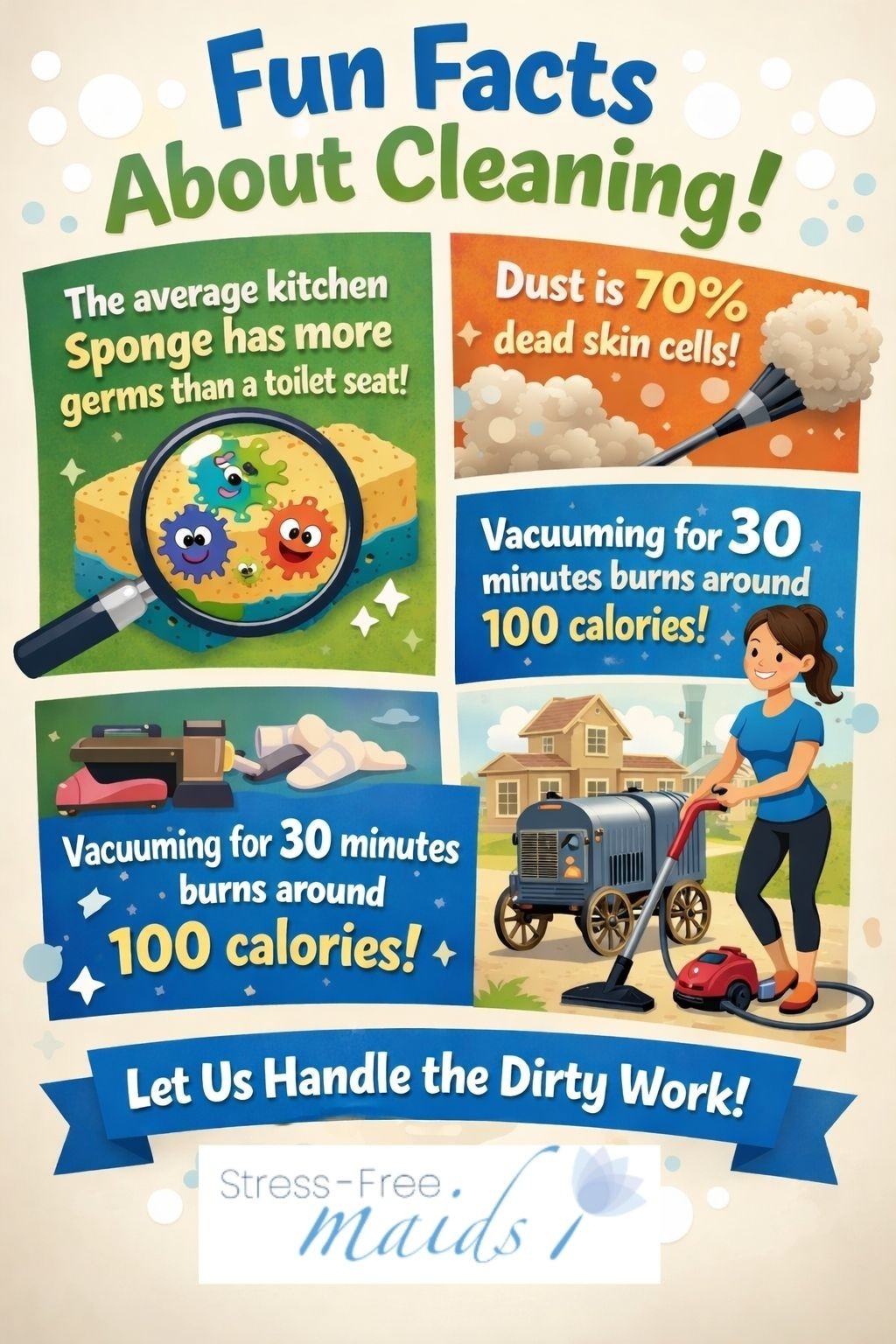.png)
The crackling sound of logs in the fireplace, the gentle warmth spreading through your living room, and the comforting aroma of burning wood—few things are as delightful as a well-maintained chimney during the cold Chicago winters. However, behind this idyllic scene lies the importance of regular chimney cleaning and maintenance. While Stress-Free Maids is known for its impeccable residential cleaning services in Chicago, we also understand the significance of chimney care for a cozy, safe home. In this guide, we'll explore the art of chimney cleaning, revealing expert tips and essential information to keep your chimney in top shape. Remember, even though we don't currently offer chimney cleaning services, we're here to provide valuable insights to help you maintain a clean and safe home environment.
The Importance of a Clean Chimney
Why Cleanliness Matters
A clean chimney is vital for maintaining the efficiency and safety of your fireplace or wood-burning stove. Over time, soot and creosote (a byproduct of burning wood) accumulate in the chimney, forming a highly flammable residue. When not addressed, this buildup can obstruct the chimney, leading to improper ventilation, decreased heating efficiency, and even chimney fires. Regular chimney cleaning removes these obstructions, ensuring that your fireplace functions optimally.
Safety First: Avoiding Fire Hazards
Chimney fires are more common than you might think. Creosote buildup inside the chimney can ignite, causing an extremely hot and dangerous fire. These fires often go unnoticed until they become uncontrollable. By scheduling regular chimney cleaning, you significantly reduce the risk of chimney fires, protecting your home and loved ones.
Maintaining Indoor Air Quality
A clean chimney not only prevents fire hazards but also contributes to better indoor air quality. When creosote and soot accumulate, they can release harmful pollutants and unpleasant odors into your home. Proper chimney cleaning ensures that the air you breathe remains fresh and clean, especially during the heating season.
Signs Your Chimney Needs Cleaning
Creosote Buildup
The most common sign that your chimney requires cleaning is the buildup of creosote. This black, tar-like substance accumulates on the chimney's inner walls and is highly flammable. If you notice a thick layer of creosote, it's time for a cleaning.
Smoke Problems
If your fireplace consistently produces excessive smoke or has trouble drawing air up the chimney, this could be due to obstructions or creosote buildup. Cleaning the chimney can resolve these issues and improve ventilation.
Unpleasant Odors
Foul odors emanating from your fireplace or chimney are often a result of creosote and soot buildup. Regular cleaning eliminates these odors, leaving your home smelling fresh.
Visible Soot
If you can see a layer of soot on the fireplace walls or in the firebox, it's a clear indicator that your chimney needs cleaning. Soot buildup can reduce heating efficiency and pose a fire risk.
DIY Chimney Cleaning: Tips and Tricks
Necessary Tools and Supplies
Before you begin cleaning your chimney, gather the necessary tools and supplies. These typically include a chimney brush, extension rods, a flashlight, a mirror, a drop cloth or tarp, a bucket, and safety gear such as gloves and safety goggles.
Step-by-Step Cleaning Guide
- Prepare the Area: Lay a drop cloth or tarp around the fireplace to catch debris. Remove any furniture or objects near the fireplace.
- Inspect the Chimney: Shine a flashlight up the chimney to assess the level of creosote buildup and identify any obstructions.
- Seal the Fireplace: Close the damper and use a mirror to block off the firebox opening. This prevents soot and debris from falling into your home.
- Attach the Brush: Attach the chimney brush to the extension rods, ensuring it's securely fastened.
- Scrub the Flue: Insert the brush into the chimney and scrub the flue vigorously. Work in an up-and-down motion to dislodge creosote and soot.
- Remove Debris: Use the bucket to collect debris that falls down the chimney. Continue brushing until the flue is clean.
- Inspect and Clean the Firebox: Remove the mirror from the firebox opening and inspect it for any remaining debris. Clean the firebox and surrounding area.
- Clean the Chimney Cap: If your chimney has a cap, clean it of debris and check for damage.
Safety Precautions
Chimney cleaning can be a dirty and physically demanding task. Always wear appropriate safety gear, including gloves and safety goggles, to protect yourself from soot and debris. If you're uncomfortable with heights or unsure about the cleaning process, it's best to hire professionals.
Chimney Maintenance: Yearly Checklist
While regular cleaning is essential, yearly chimney maintenance helps prevent long-term damage and ensures safe operation. Here's a checklist of maintenance tasks:
Inspecting the Chimney Cap: Check that the chimney cap is securely in place and free of debris. A damaged or missing cap can allow animals, debris, and moisture into your chimney.
Cleaning the Firebox: Remove ashes and debris from the firebox. Inspect the firebrick lining for cracks or damage. Clean any accumulated soot.
Checking for Cracks and Damage: Inspect the chimney's exterior for signs of damage or wear. Look for loose bricks, crumbling mortar, or damaged flashing. Addressing these issues promptly prevents costly repairs later on.
Scheduling Professional Inspections: While you can perform some maintenance tasks, it's crucial to schedule professional chimney inspections annually. Certified chimney sweeps can identify hidden issues, provide expert cleaning, and ensure your chimney operates safely.
In conclusion, chimney cleaning and maintenance are vital aspects of home ownership, especially in regions with cold winters like Chicago. Regular cleaning, DIY maintenance, and professional inspections are essential to keep your chimney safe, efficient, and ready to provide cozy warmth during the winter months. While Stress-Free Maids doesn't offer chimney cleaning services currently, we're always here to provide valuable guidance to help you maintain a clean and safe home environment.
FAQs
How often should I clean my chimney?
Chimney cleaning frequency depends on how often you use your fireplace or stove. For regular users, an annual cleaning is recommended. However, if you notice significant creosote buildup or other issues, don't hesitate to clean it more frequently.
Can I use any cleaning products?
It's best to avoid chemical cleaning products for chimneys. Stick to using a chimney brush, extension rods, and manual labor. Chemicals can be hazardous and may not effectively remove creosote.
What is creosote, and why is it dangerous?
Creosote is a tar-like substance that forms during wood combustion. It's highly flammable and can accumulate in the chimney, leading to chimney fires. Regular cleaning is essential to remove creosote buildup.
How do I prevent chimney fires?
Preventing chimney fires involves regular cleaning, proper ventilation, and burning seasoned hardwoods. Also, ensure your chimney cap is in good condition to prevent debris from entering.
When should I hire professionals?
While some maintenance tasks can be DIY, it's wise to hire professionals for annual inspections and any major cleaning or repairs. Professionals have the expertise and equipment to ensure your chimney operates safely.





